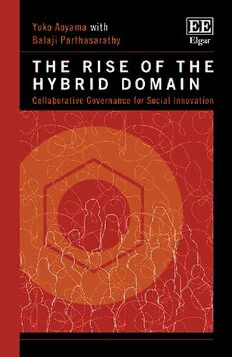
The Rise of the Hybrid Domain: Collaborative Governance for Social Innovation PDF
Preview The Rise of the Hybrid Domain: Collaborative Governance for Social Innovation
JOBNAME:Aoyama PAGE:1 SESS:2 OUTPUT:TueNov1509:42:152016 TheRiseoftheHybridDomain ColumnsDesignXMLLtd / Job:Aoyama-Rise_of_the_hybrid_domain / Division:Prelims /Pg.Position:1/ Date:21/9 JOBNAME:Aoyama PAGE:2 SESS:2 OUTPUT:TueNov1509:42:152016 ColumnsDesignXMLLtd / Job:Aoyama-Rise_of_the_hybrid_domain / Division:Prelims /Pg.Position:2/ Date:21/9 JOBNAME:Aoyama PAGE:3 SESS:5 OUTPUT:TueNov1509:42:152016 The Rise of the Hybrid Domain Collaborative Governance for Social Innovation YukoAoyama Professor,GraduateSchoolofGeography,ClarkUniversity,USA with BalajiParthasarathy Professor,InternationalInstituteofInformationTechnology,Bangalore, India Cheltenham,UK+Northampton,MA,USA ColumnsDesignXMLLtd / Job:Aoyama-Rise_of_the_hybrid_domain / Division:Prelims /Pg.Position:1/ Date:27/10 JOBNAME:Aoyama PAGE:4 SESS:5 OUTPUT:TueNov1509:42:152016 ©YukoAoyamaandBalajiParthasarathy2016 Allrightsreserved.Nopartofthispublicationmaybereproduced,storedina retrievalsystemortransmittedinanyformorbyanymeans,electronic,mechanical orphotocopying,recording,orotherwisewithoutthepriorpermissionofthe publisher. Publishedby EdwardElgarPublishingLimited TheLypiatts 15LansdownRoad Cheltenham GlosGL502JA UK EdwardElgarPublishing,Inc. WilliamPrattHouse 9DeweyCourt Northampton Massachusetts01060 USA Acataloguerecordforthisbook isavailablefromtheBritishLibrary LibraryofCongressControlNumber:2016949920 Thisbookisavailableelectronicallyinthe SocialandPoliticalSciencesubjectcollection DOI10.4337/9781785360435 ISBN9781785360428(cased) ISBN9781785360435(eBook) TypesetbyColumnsDesignXMLLtd,Reading 2 0 ColumnsDesignXMLLtd / Job:Aoyama-Rise_of_the_hybrid_domain / Division:Prelims /Pg.Position:2/ Date:27/10 JOBNAME:Aoyama PAGE:5 SESS:5 OUTPUT:TueNov1509:42:152016 Contents Listoftables ix Acknowledgments x Listofabbreviations xii 1 Introduction 1 1.1 The hybrid domain 1 1.2 Social innovation in India 5 1.3 Methodology 9 1.3.1 Questionnaire survey of R&D activities of multinational enterprises 9 1.3.2 Semi-structured interviews with social innovation stakeholders 10 1.4 Book organization 11 1.5 Caveats 13 2 Rescalingcollectiveactionforgovernanceinthetwenty-first century 15 2.1 Governing global public goods 15 2.1.1 State–market dichotomy 16 2.1.2 Problems with public goods 18 2.1.3 From local to global commons: global merit goods 20 2.2 Polycentric and network forms of governance 22 2.2.1 Polycentric governance 22 2.2.2 Network forms of governance 24 2.2.3 Heterarchies 24 2.2.4 Institutional “bricolage” 26 2.3 Conclusion 27 3 Thehybriddomain:bridgingthestate–marketdivide 28 3.1 The rise of the hybrid domain 29 3.2 Domain and scalar flexibility 31 3.3 Actors in the hybrid domain 33 3.3.1 Corporations: from shareholder to stakeholder governance 34 v ColumnsDesignXMLLtd / Job:Aoyama-Rise_of_the_hybrid_domain / Division:Prelims /Pg.Position:1/ Date:27/10 JOBNAME:Aoyama PAGE:6 SESS:5 OUTPUT:TueNov1509:42:152016 vi Theriseof thehybriddomain 3.3.2 Corporate social responsibility (CSR) initiatives 37 3.3.3 NGOs in transition 38 3.3.4 Social enterprises 40 3.3.5 Transnational social entrepreneurs (TSEs) 43 3.3.6 From traditional to venture philanthropy 44 3.3.7 The rise of impact investment 49 3.4 Conclusion 51 4 Socialinnovationinglobalcontexts 53 4.1 Social innovation 53 4.1.1 Defining social innovation 53 4.1.2 Context in social innovation 56 4.1.3 Proximity in social innovation 57 4.1.4 Technology in social innovation 59 4.1.5 Sustainability in social innovation 60 4.2 Collaborative governance for social innovation 61 4.2.1 Corporations 61 4.2.2 Users and consumers 64 4.2.3 Incentivizing social innovation 65 4.2.4 The state in social innovation 67 4.3 Conclusion 68 5 SocialinnovationinIndia 69 5.1 Failure of the state to provide public goods 70 5.1.1 The Nehruvian ideal of scientific and technological self-sufficiency 71 5.1.2 The Gandhian ideal of decentralized self-reliance 76 5.1.3 Inclusive development 80 5.2 Failure of the market to provide public goods: the myth of the BOP 82 5.2.1 The myth of profitability 84 5.2.2 Opportunities and challenges 87 5.2.3 From BOP to “emerging market” consumers 90 5.3 Conclusion 91 6 Designingsolutionsfor“wickedproblems” 93 6.1 Designing solutions 93 6.1.1 De-featuring and frugal innovation 94 6.1.2 Bottom-up design 95 6.1.3 Design for constraints 96 6.1.4 Cross-sectoral solutions 99 6.2 India as a laboratory for social innovation 101 ColumnsDesignXMLLtd / Job:Aoyama-Rise_of_the_hybrid_domain / Division:Prelims /Pg.Position:2/ Date:27/10 JOBNAME:Aoyama PAGE:7 SESS:8 OUTPUT:WedNov1608:44:112016 Contents vii 6.2.1 Learning for social impacts: contexts and proximity 101 6.2.2 South–South knowledge transfer and reverse innovation 106 6.3 Conclusion 111 7 CasestudiesfromIndia 112 7.1 Innovating on healthcare delivery and medical diagnostics 112 7.1.1 Rural healthcare franchising with local social networks 113 7.1.2 From thermoplastics to silk fabric chips for immunoassays 115 7.1.3 Dry reagents for resource-constrained supply chains 116 7.2 Resolving information asymmetries for small-scale farmers 117 7.2.1 Video-based content creation and distribution 118 7.2.2 Text messaging service for crop prices 119 7.2.3 Building farmers’capacities to reach markets 121 7.3 Promoting inclusive development for rural populations 122 7.3.1 Voice-enabled mobile phone platform for tribal communities 122 7.3.2 ICT employment creation and training in rural areas 124 7.3.3 “Bank-less” banking for rural migrants 125 7.4 Sustaining livelihoods in the informal sector 127 7.4.1 Training and skill certification for construction workers 127 7.4.2 An employment portal for informal work 129 7.4.3 Enhancing the cash flows and creditworthiness of rural informal retailers 131 7.5 Introducing renewable energy 132 7.5.1 Solar systems as a catalyst for social change 133 7.5.2 Micro-franchises for renewable energy 135 7.6 What the cases tell us 136 8 Domainflexibility 138 8.1 From CSR to shared value creation 138 8.1.1 The limits of goodwill 138 8.1.2 Shared value creation: opportunities and challenges 140 ColumnsDesignXMLLtd / Job:Aoyama-Rise_of_the_hybrid_domain / Division:Prelims /Pg.Position:3/ Date:16/11 JOBNAME:Aoyama PAGE:8 SESS:5 OUTPUT:TueNov1509:42:152016 viii Theriseof thehybriddomain 8.1.3 The socially sustainable business model (SSBM) 142 8.2 Learning through collaborating 144 8.2.1 Varieties of collaborative arrangements 145 8.2.2 Collaborating with the state 154 8.2.3 Challenges in collaboration 156 8.3 The rise of hybrid organizations 163 8.3.1 Transitions from NGOs to social enterprises 164 8.3.2 NGOs established by social enterprises 167 8.3.3 The Robin Hood model 169 8.3.4 Corporations established by NGOs 170 8.3.5 Joint NGO–corporate set-up and collaborative polygon 171 8.4 Conclusion 172 9 Scalarflexibility 174 9.1 Globalizing social enterprises 174 9.2 The role of universities in the Global North 176 9.3 Looking for impacts, practice-oriented research 179 9.4 Accessing transnational financing 182 9.5 Conclusion 185 10 Conclusions 187 Appendix 192 References 195 Index 223 ColumnsDesignXMLLtd / Job:Aoyama-Rise_of_the_hybrid_domain / Division:Prelims /Pg.Position:4/ Date:27/10 JOBNAME:Aoyama PAGE:9 SESS:7 OUTPUT:TueNov1509:42:152016 Tables 3.1 PrivatefoundationsintheUnitedStates 46 5.1 Macro-economicindicators:BRICScountries 69 5.2 Education,health,andinfrastructureindicators,BRICScountries 71 5.3 AverageannualGDPgrowthrateinIndia 73 5.4 InfrastructurespendingasashareofGDP,India 74 5.5 RegisteredNGOsinIndia 78 5.6 SourcesoffundingforNGOsinIndia 79 5.7 Resultsfromthesurveyquestionnaire:R&DforBOPmarkets 83 6.1 Resultsfromthesurveyquestionnaire:sourcesofknowledgefor theBOPmarket 102 7.1 Healthcaresystemindicators,BRICScountries 113 7.2 Urbannon-agriculturalinformalemployment,India(percentage distributionbysector,2011–2012) 128 8.1 Illustrativeexamplesofcollaborationinthehybriddomain 145 8.2 Resultsofthequestionnairesurvey:MNE–NGOcollaboration 150 A.1 Listofinterviewees 192 ix ColumnsDesignXMLLtd / Job:Aoyama-Rise_of_the_hybrid_domain / Division:Prelims /Pg.Position:1/ Date:15/11
